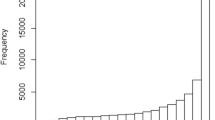Abstract
This article presents a new database of 2,654 German nouns rated by a sample of 3,907 subjects on three psycholinguistic attributes: concreteness, valence, and arousal. As a new means of data collection in the field of psycholinguistic research, all ratings were obtained via the Internet, using a tailored Web application. Analysis of the obtained word norms showed good agreement with two existing norm sets. A cluster analysis revealed a plausible set of four classes of nouns: abstract concepts, aversive events, pleasant activities, and physical objects. In an additional application example, we demonstrate the usefulness of the database for creating parallel word lists whose elements match as closely as possible. The complete database is available for free from ftp://ftp.uni-duesseldorf.de/pub/psycho/lahl/WWN. Moreover, the Web application used for data collection is inherently capable of collecting word norms in any language and is going to be released for public use as well.
Similar content being viewed by others
References
Algarabel, S., Ruiz, J. C., & Sanmartin, J. (1988). The University of Valencia’s computerized word pool. Behavior Research Methods, Instruments, & Computers, 20, 398–403.
Altarriba, J., Bauer, L. M., & Benvenuto, C. (1999). Concreteness, context availability, and imageability ratings and word associations for abstract, concrete, and emotion words. Behavior Research Methods, Instruments, & Computers, 31, 578–602.
Baayen, R. H., Piepenbrock, R., & Gulikers, L. (1995). The CELEX lexical database (Release 2) [CD-ROM]. Philadelphia: University of Pennsylvania, Linguistic Data Consortium.
Balota, D. A., Pilotti, M., & Cortese, M. J. (2001). Subjective frequency estimates for 2,938 monosyllabic words. Memory & Cognition, 29, 639–647.
Barca, L., Burani, C., & Arduino, L. S. (2002). Word naming times and psycholinguistic norms for Italian nouns. Behavior Research Methods, Instruments, & Computers, 34, 424–434.
Birnbaum, M. H. (2004). Human research and data collection via the Internet. Annual Review of Psychology, 55, 803–832.
Brown, G. D. A. (1984). A frequency count of 190,000 words in the London-Lund Corpus of English Conversation. Behavior Research Methods, Instruments, & Computers, 16, 502–532.
Brown, W. P., & Ure, D. M. J. (1969). Five rated characteristics of 650 word association stimuli. British Journal of Psychology, 60, 233–249.
Clark, J. M., & Paivio, A. (2004). Extensions of the Paivio, Yuille, and Madigan (1968) norms. Behavior Research Methods, Instruments, & Computers, 36, 371–383.
Cortese, M. J., & Fugett, A. (2004). Imageability ratings for 3,000 monosyllabic words. Behavior Research Methods, Instruments, & Computers, 36, 384–387.
Friendly, M., Franklin, P. E., Hoffman, D., & Rubin, D. C. (1982). The Toronto Word Pool: Norms for imagery, concreteness, orthographic variables, and grammatical usage for 1,080 words. Behavior Research Methods & Instrumentation, 14, 375–399.
Gilhooly, K. J., & Logie, R. H. (1980). Age-of-acquisition, imagery, concreteness, familiarity, and ambiguity measures for 1,944 words. Behavior Research Methods & Instrumentation, 12, 395–427.
Hager, W., & Hasselhorn, M. (1994). Handbuch deutschsprachiger Wortnormen. Göttingen: Hogrefe.
Izura, C., Hernández-Muñoz, N., & Ellis, A. W. (2005). Category norms for 500 Spanish words in five semantic categories. Behavior Research Methods, 37, 385–397.
Kerr, N. H., & Johnson, T. H. (1991). Word norms for blind and sighted subjects: Familiarity, concreteness, meaningfulness, imageability, imagery modality, and word associations. Behavior Research Methods, Instruments, & Computers, 23, 461–485.
Krantz, J. H., Ballard, J., & Scher, J. (1997). Comparing the results of laboratory and World-Wide Web samples on the determinants of female attractiveness. Behavior Research Methods, Instruments, & Computers, 29, 264–269.
Krantz, J. H., & Dalal, R. (2000). Validity of Web-based psychological research. In M. H. Birnbaum (Ed.), Psychological experiments on the Internet (pp. 35–60). San Diego: Academic Press.
Lahl, O., & Pietrowsky, R. (2006). EQUIWORD: A software application for the automatic creation of truly equivalent word lists. Behavior Research Methods, 38, 146–152.
Lahl, O., & Pietrowsky, R. (2008). Tracer: A general purpose software library for logging events in computerized experiments. Behavior Research Methods, 40, 1163–1169.
Lahl, O., Wispel, C., Willigens, B., & Pietrowsky, R. (2008). An ultra short episode of sleep is sufficient to promote declarative memory performance. Journal of Sleep Research, 17, 3–10.
Liu, Y., Shu, H., & Li, P. (2007). Word naming and psycholinguistic norms: Chinese. Behavior Research Methods, 39, 192–198.
Marques, J. F., Fonseca, F. L., Morais, A. S., & Pinto, I. A. (2007). Estimated age of acquisition norms for 834 Portuguese nouns and their relation with other psycholinguistic variables. Behavior Research Methods, 39, 439–444.
Osgood, C. E., & Suci, G. J. (1955). Factor analysis of meaning. Journal of Experimental Psychology, 50, 325–338.
Paivio, A., Yuille, J. C., & Madigan, S. A. (1968). Concreteness, imagery, and meaningfulness values for 925 words. Journal of Experimental Psychology Monograph Supplement, 76(1, Pt. 2).
Pérez, M. A., & Navalón, C. (2005). Objective-AoA norms for 175 names in Spanish: Relationships with other psycholinguistic variables, estimated AoA, and data from other languages. European Journal of Cognitive Psychology, 17, 179–206.
Reips, U. D. (2000). The Web experiment method: Advantages, disadvantages, and solutions. In M. H. Birnbaum (Ed.), Psychological experiments on the Internet (pp. 89–117). San Diego: Academic Press.
Stadthagen-Gonzalez, H., & Davis, C. J. (2006). The Bristol norms for age of acquisition, imageability, and familiarity. Behavior Research Methods, 38, 598–605.
Stevenson, R. A., Mikels, J. A., & James, T. W. (2007). Characterization of the Affective Norms for English Words by discrete emotional categories. Behavior Research Methods, 39, 1020–1024.
Toglia, M. P., & Battig, W. F. (1978). Handbook of semantic word norms. Hillsdale, NJ: Erlbaum.
van Casteren, M., & Davis, M. H. (2007). Match: A program to assist in matching the conditions of factorial experiments. Behavior Research Methods, 39, 973–978.
Võ, M. L.-H., Jacobs, A. M., & Conrad, M. (2006). Cross-validating the Berlin Affective Word List. Behavior Research Methods, 38, 606–609.
Author information
Authors and Affiliations
Corresponding author
Rights and permissions
About this article
Cite this article
Lahl, O., Göritz, A.S., Pietrowsky, R. et al. Using the World-Wide Web to obtain large-scale word norms: 190,212 ratings on a set of 2,654 German nouns. Behavior Research Methods 41, 13–19 (2009). https://doi.org/10.3758/BRM.41.1.13
Received:
Accepted:
Published:
Issue Date:
DOI: https://doi.org/10.3758/BRM.41.1.13




